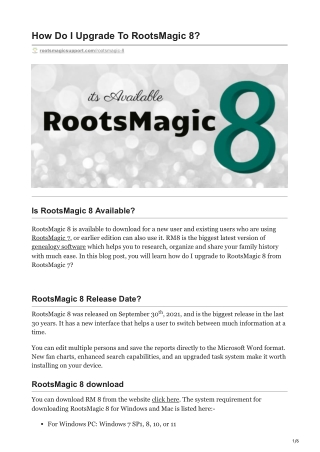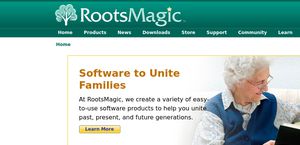

- ROOTSMAGIC 8 REVIEW HOW TO
- ROOTSMAGIC 8 REVIEW UPDATE
- ROOTSMAGIC 8 REVIEW UPGRADE
- ROOTSMAGIC 8 REVIEW PRO
- ROOTSMAGIC 8 REVIEW CODE
These will be identified as encountered through usage and testing. New OwnerType values have been added in support of the new tables. New table added in support of Saved Criteria Search and Saved Criteria Group.

They bear a resemblance, respectively, to the EventTable and FactTypeTable. New tables added in support of the new Associations feature.

However, #RM9 and #RM8 table structures are identical with the following exceptions: PersonTableĩ new fields named color1, …, color9 have been added in support of the ColorCode sets 1 through 10.
ROOTSMAGIC 8 REVIEW UPGRADE
All previous version #database files undergo an upgrade procedure to the RM9 structure and are not backward compatible. RootsMagic 9.0.0.0 was released on with some new features necessitating changes to the database design. Categories: Database Tags: #database, #datadefinitions, #rm9 Discussion: 5 Comments RM9 Database Diagram #rm9 #database
ROOTSMAGIC 8 REVIEW PRO
And there is a Pro version which adds many more capabilities. But it is much more powerful than that as it looks to be a multi-database manager with which one can query the database data.
ROOTSMAGIC 8 REVIEW HOW TO
It is self-described as a “Universal Database Tool” and I’ve only superficially scratched its surface figuring out how to connect a SQLite database, generate the ERD from its definition and edit it to illustrate relationships. Having searched around for a (free) application that could create an Entity Relationship Diagram (ERD) from a SQLite 3 database, I landed on one that might be described as an Integrated Development Environment (IDE) for databases, the DBeaver Community Edition.
ROOTSMAGIC 8 REVIEW UPDATE
Maybe not the best example for comparison because I don’t think RM would update the EventTable when a media item is tagged to an event. UPDATE Evenements SET DateModification=MAX(NEW.DateModification, Evenements.DateModification) WHERE Evenements.CodeID=NEW.XrefEvenement Looks like this: CREATE TRIGGER "MajDateMediasEvenementInsert" For example, H has a trigger named “MajDateMediasEvenementInsert” which automatically updates the ‘Date modified’ value in its ‘EventTable’ when a link has been added to their ‘MediaLinkTable’.
ROOTSMAGIC 8 REVIEW CODE
H has many routine operations embedded in the database, being executed by the database engine, rather than in the higher level code which then has to talk to the database engine to make the same thing happen. This is the most pronounced difference between RM and H. What I have yet to find out is if there is any custom collation sequence in H as there is in RM which has given us database explorers so much grief. Maybe H developers have attempted to cover all the possible bases with explicit indexes.

SQLite is itself very good at optimising queries and may spawn an index that it thinks is appropriate unless there is a pre-defined one that includes all the key fields of the query. I don’t know why there should be triple but, in the past, I’ve suggested an index be added or revised in RM. With double the number of tables, it stands to reason that there could be double the number of indexes. It’s possible that both applications do, too, but we cannot see them from outside the app’s sqlite engine. I’ve used temporary Views on RM databases, lasting until the database is closed by the sqlite manager. Neither has stored views (stored queries) so that tells us nothing. I’m not using H sufficiently to identify the differences and my understanding of table and field names in French is not thorough. Similarly, RM’s MediaLinkTable which relates a media item to a Person, Couple, Event, Source, Citation, Place… (according to an OwnerType value) is achieved in H by separate tables for each ‘OwnerType’. Moreover, H has names in multiple tables: the Primary appears to be in the equivalent of RM’s PersonTable (Individus) while there is another for Surnames (Noms) and one for Given Names (Prenoms).


 0 kommentar(er)
0 kommentar(er)
